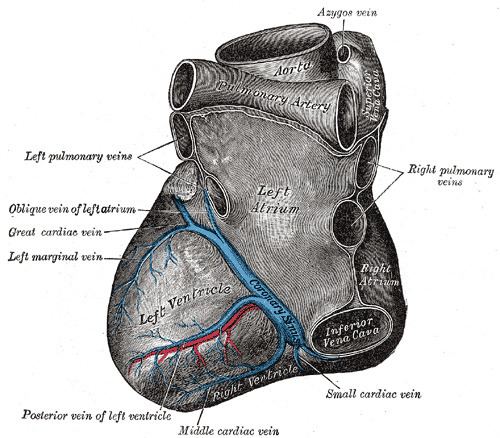TA A12.3.01.013 | FMA 71568 | |
 | ||
Latin Venae cardiacae minimae,venae cordis minimae | ||
The smallest cardiac veins (or thebesian veins) are minute valveless veins in the walls of all four heart chambers. The veins are sometimes accurately referred to as vessels, but they are frequently confused with a distinct set of artery connections eponymously referred to as the "vessels of Wearn". In his 1928 publication, Wearn himself referred to the arterio- nscb connections (vessels of Wearn) as thebesian. However, Wearn's 1933 and 1941 publications emphatically described the thebesian veins as distinct from arterio-cameral vessels.
The thebesian veins are reportedly most abundant in the right atrium and least in the left ventricle. They drain the myocardium and run a perpendicular course to the endocardial surface, directly connecting the heart chambers to the medium-sized, and larger coronary veins. Thebesian veins have been successfully identified by following the route of contrast flow - during catheterization procedures - from the subendocardium, through the thebesian veins, into larger veins, and into the coronary sinus. The coronary sinus empties into the right atrium.
The thebesian venous network is considered an alternative venous drainage of the myocardium. Thebesian veins draining into the left heart, along with deoxygenated blood originating from the bronchial veins draining into the pulmonary veins, contribute to normal physiologic shunting of blood. As a consequence of the input of these vessels, blood in the left heart is less oxygenated than the blood found at the pulmonary capillary beds, albeit to a very small degree.
The openings of smallest cardiac veins are located in the endocardium. Here the smallest cardiac veins return blood into the heart chambers from the capillary bed in the muscular cardiac wall, enabling a form of collateral circulation unique to the heart. Not every endocardial opening connects to the thebesian veins as some connect to the vessels of Wearn, which are arteries. Therefore, the endocardial opening must be traced to a vein before it is definitely called an opening of the smallest cardiac veins.
The thebesian veins are named after the German anatomist Adam Christian Thebesius, who described them in a 1708 treatise called Disputatio medica inauguralis de circulo sanguinis in corde.
